Conveyor Belts
Conveyor belts are transportation systems used to move goods, bulk materials, or energy by means of rollers, wheels, and pulleys that drive and support a continuously moving platform. These systems can range from simple setups—such as a belt looped around two rollers mounted on a frame—to highly complex configurations. More advanced conveyor systems are designed to manage multiple stages of manufacturing, from handling raw materials to packing products for shipment and everything in between. Conveyor belts can also vary widely in size: they may be as small as the drive belts used in household appliances like vacuum cleaners and sewing machines, or as large and powerful as those used to transport farm machinery, aircraft, and even the Space Shuttle.
Conveyor Belts FAQ
What is a conveyor belt used for in industrial applications?
A conveyor belt transports goods, bulk materials, or components through manufacturing, packaging, and distribution processes. These systems are used in industries such as automotive, food processing, and logistics to move items efficiently while reducing manual handling.
Who invented the first conveyor belt system?
The first conveyor belt was introduced in 1795, featuring a hand-cranked pulley system with a leather belt. In 1892, Thomas Robins developed a conveyor belt to transport coal, marking the beginning of modern industrial conveyor systems.
What materials are conveyor belts made from?
Conveyor belts are commonly made from rubber, plastic, PVC, metal mesh, or fabric materials like polyester and aramid. Each material is selected based on its strength, flexibility, and suitability for specific environments such as food-grade or heavy-duty applications.
How are food-grade conveyor belts designed for sanitation?
Food-grade conveyor belts are made from materials such as Teflon-coated urethane or silicone and feature sealed edges and smooth, non-porous surfaces. These designs prevent contamination and allow easy cleaning to meet FDA and USDA safety standards.
What are the different types of conveyor systems used in manufacturing?
Common conveyor systems include roller, vertical, vibrating, pneumatic, and heavy-duty conveyors. Each type serves a specific purpose—from moving lightweight powders to transporting large industrial components or materials between production levels.
Why is regular maintenance important for conveyor belts?
Regular maintenance prevents belt slippage, stretching, and misalignment while ensuring safe and efficient operation. Proper tensioning, lubrication, and routine inspection of pulleys, rollers, and fasteners extend system lifespan and reduce costly downtime.
Where are conveyor systems commonly found in the United States?
Conveyor systems are widely used in U.S. manufacturing plants, postal facilities, airports, and food-processing centers. They handle everything from baggage at airports to packaged goods in Midwest factories and agricultural products across Southern states.
The History of Conveyor Belts
Conveyor belts and systems, though now essential to modern industry, are a relatively recent innovation in historical terms. The first officially recognized conveyor was introduced in 1795. It featured a leather belt stretched across a wooden slider bed and operated by a hand-cranked pulley system. This early conveyor was primarily used for loading materials onto ships. By 1804, the British Navy had developed a steam-powered conveyor to automate biscuit production.
In 1892, Thomas Robins began developing a conveyor belt system designed specifically to transport coal. These early belts were constructed from wide leather strips, stitched together with wire for added strength. Then, in 1901, Swedish engineer Sandvik invented the first steel conveyor belt, which was used to transport gravel. Just a few years later, in 1905, Richard Sutcliffe transformed the mining industry by introducing conveyor systems to underground mining operations in Ireland.
The roller conveyor made its debut in 1908, paving the way for even more efficient material handling. In 1913, Henry Ford famously implemented the first conveyor belt-driven assembly line in automotive manufacturing, revolutionizing production methods and setting the stage for modern industrial assembly lines—many of which are still in use today across countless industries.
A major leap in conveyor belt technology came in 1957 when the B.F. Goodrich Company patented a rubberized steel belt known as a Mobius strip. This innovative design incorporated a half twist in the belt, allowing both sides of the surface to be used and effectively extending the belt’s lifespan. While the Mobius belt was eventually phased out in favor of layered materials that offered greater durability, it marked a significant advancement in belt construction.
In 1970, the first all-plastic conveyor belts were patented by Intralox, a Louisiana-based company. As polymer technologies rapidly advanced, plastic belts emerged as a practical and versatile alternative to traditional materials, expanding the possibilities for conveyor system design and performance in a variety of industries.
Conveyors of Convenience and Commerce
Conveyor belts play a crucial role in transporting products that are irregularly shaped, delicate, bulky, or otherwise difficult to handle—items that might slow operations to an inefficient or unprofitable pace. These products can range from pharmaceutical pills and grains to glassware, live plants, railcar couplers, or massive engine blocks destined for ocean-faring vessels.
While most belt conveyor systems are horizontal, many are engineered to move goods vertically, at steep inclines, or along curves and corners. These systems reduce the need for manual handling or heavy lifting equipment such as forklifts and pallet jacks. Variations of conveyor systems are also used for transporting people—examples include escalators, moving walkways, and certain types of ski lifts.
Modern conveyor systems often feature integrated safety mechanisms designed to prevent accidents and minimize product loss. One of the most familiar examples is the conveyor at a grocery store checkout line, which includes safety guards and automatic stops for both efficiency and protection. Drive belts used in automobiles represent another widespread application of conveyor belt technology, showcasing how integral these systems are in everyday life.
Conveyors are found across an immense range of facilities. Major manufacturers, packagers, and production companies depend on them to move products efficiently through each stage of the manufacturing or packaging process—whether they’re handling bottled beverages, plastic toys, or full-scale vehicles. Logistics companies and package delivery services use conveyors to sort and route parcels. The U.S. Postal Service, for example, relies on vast conveyor systems to manage mail delivery across the entire country.
At airports, automated conveyor systems are central to baggage handling, moving luggage from check-in counters to departure gates. These systems are equipped with scanners to read baggage tags and sensors that direct each piece to its proper destination.
In the food service industry, conveyor systems are used at virtually every stage—from harvest to final plate. Harvesting equipment often features conveyors to lift crops gently from the field and load them into transport vehicles. After transport, conveyor belts move the food through stages of washing, processing, and packaging, guiding products along their journey to grocery shelves or restaurant kitchens. Much of this equipment is made from stainless steel and fitted with food-grade components. The belts themselves are often made from materials like Teflon-coated urethane to ensure easy and thorough sanitization.
Putting the Belt on Conveyors
The common conveyor belt is constructed in multiple layers, with the core layer known as the "carcass." This bed is usually composed of mesh fabric woven from steel or nylon wire and is positioned between a top and bottom cover. The carcass provides the belt with its longitudinal, or warp, strength, along with elasticity and resilience. The cross weave, or weft, enhances flexibility while protecting the belt from lateral damage.
Carcass materials may include cotton, polyester, or aramid fibers. Aramid, a fiber also used in ballistic composites, is especially valued for its exceptional strength, heat resistance, and bulletproof qualities. The outer covers of the belt are generally made from rubber compounds, plastic, or polyvinyl chloride (PVC), selected for their durability and compatibility with specific applications.
Wire belts, also known as wire mesh belts, are created by weaving steel cords or forming metal links, similar to chainmail. Solid steel belts, constructed from hinged bars linked together, are used in operations that demand the transport of extremely heavy loads.
Food-grade conveyor belts are typically manufactured from silicone, urethane, or Teflon-based materials and often incorporate anti-microbial additives to meet consumer safety standards and regulatory requirements set by the FDA or USDA. These belts must have sealed edges and smooth surfaces to prevent contamination buildup and facilitate easy cleaning. Many are also designed to resist heat, chemicals, and oils. For applications requiring high heat resistance, materials such as Kevlar®, Nomex®, or fiberglass are commonly used.
V-belts, which are typically steel-reinforced rubber belts, come in various forms including smooth, cogged, notched, or ribbed designs to meet specific needs. These belts are used to transmit power, regulate timing, and manage energy delivery in applications that demand high tensile strength. V-belts are most widely recognized for their role in vehicles, where they function as timing belts, fan belts, power steering belts, air conditioning belts, and serpentine drive belts.
Endless conveyor belts are either molded through a process called vulcanization or woven to precise lengths, forming a continuous loop with no beginning or end. This seamless design ensures smooth operation and uniform wear across the entire belt. In contrast, belts that require joining must be spliced. One method of splicing is clipper lacing, which uses a stitched wire pattern to create a strong yet flexible connection, allowing for quiet and consistent belt performance.
Conveyors Images, Diagrams and Visual Concepts
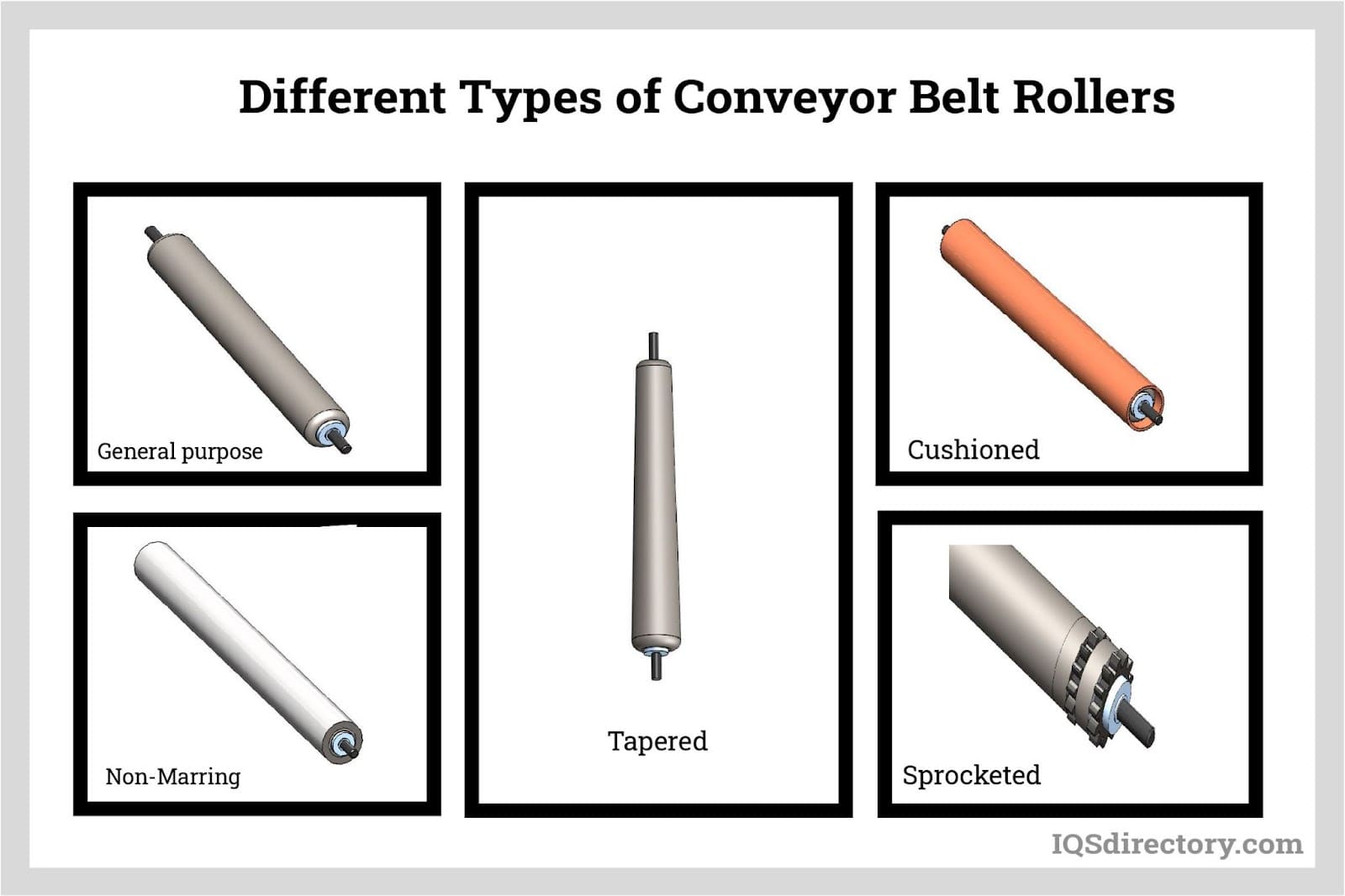 Rollers support the materials on the conveyor belt as they move along the belt and support the belt during the return.
Rollers support the materials on the conveyor belt as they move along the belt and support the belt during the return.
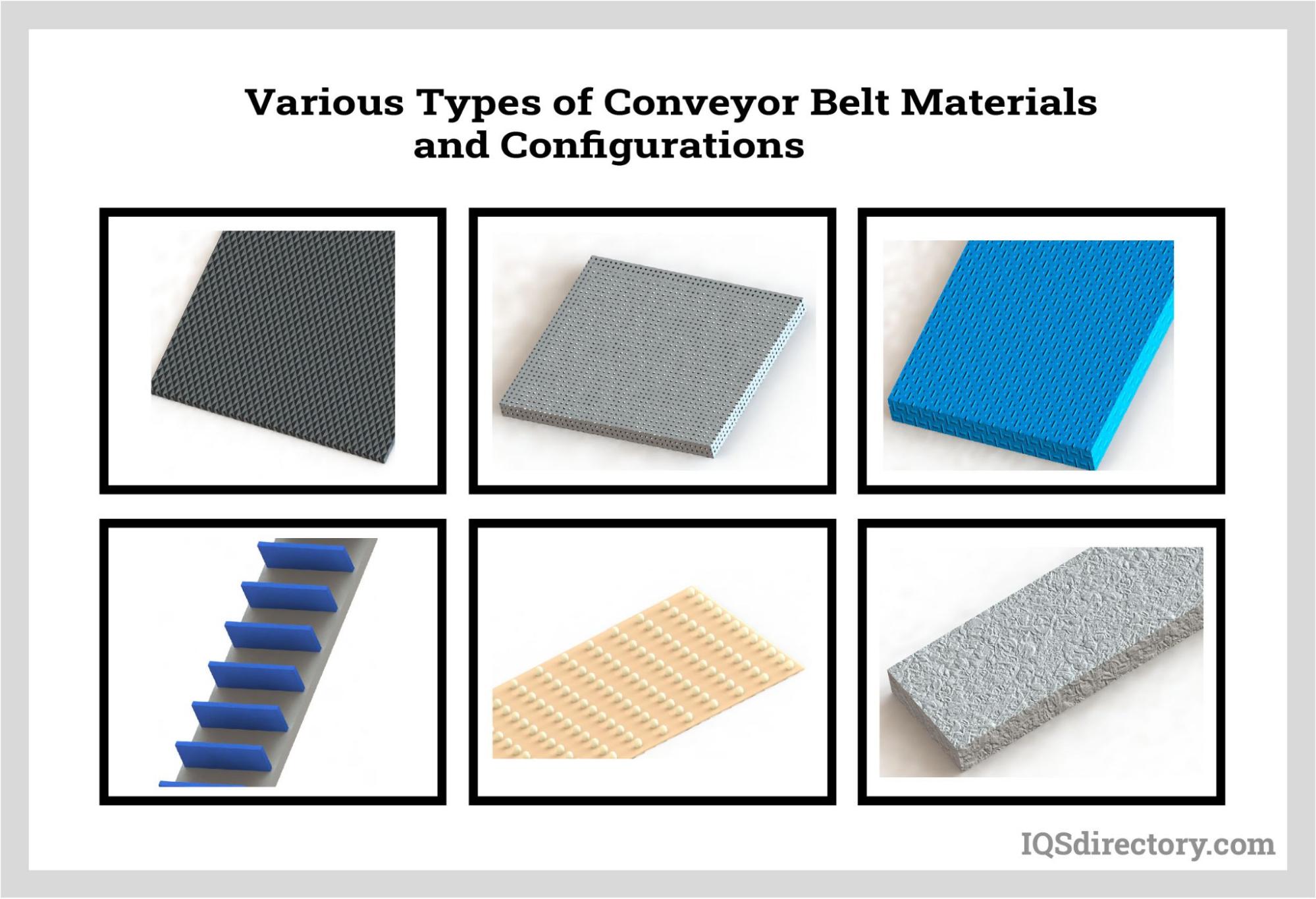 The different materials and configurations for conveyor belts.
The different materials and configurations for conveyor belts.
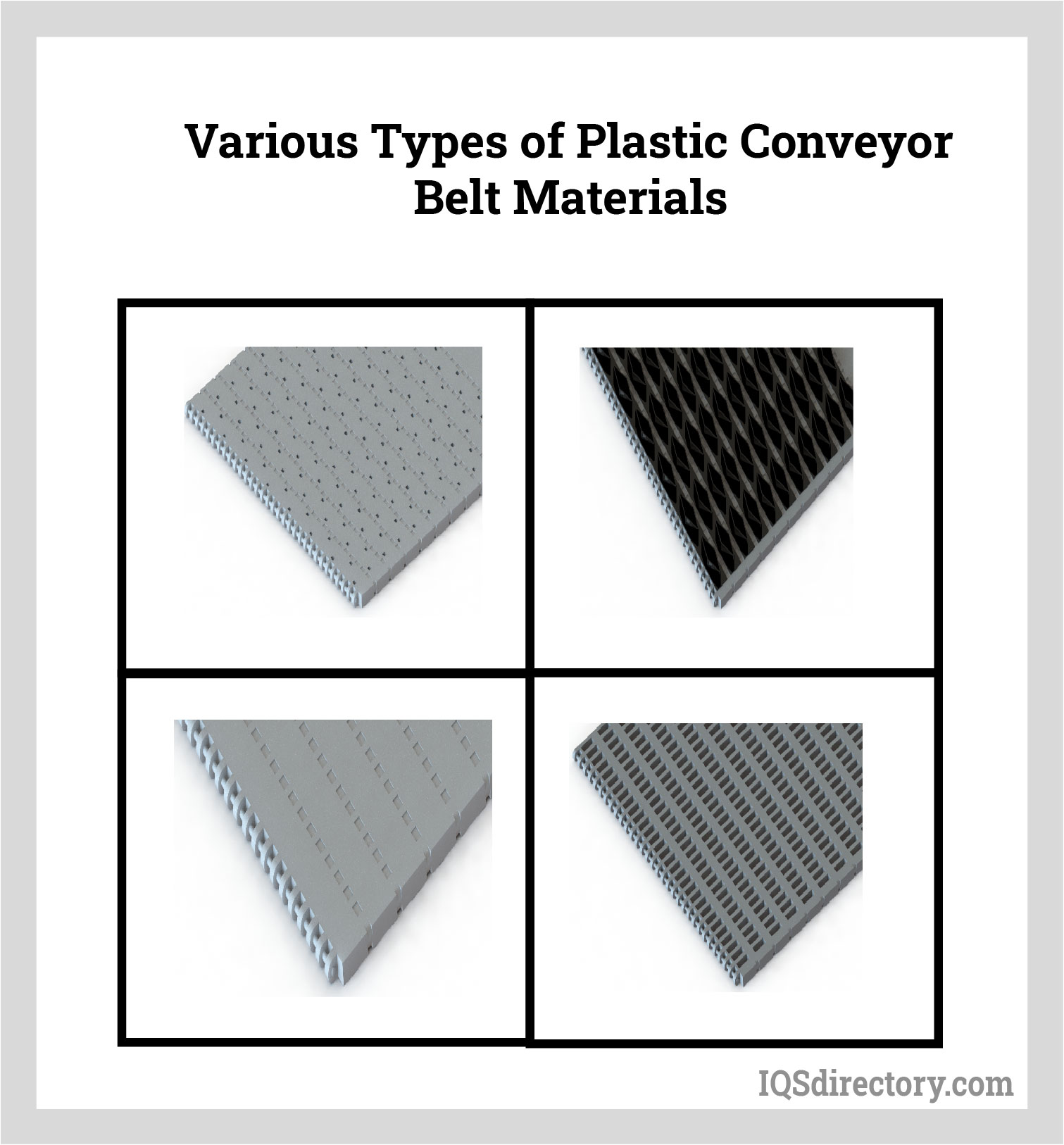 Plastic conveyor belts are lightweight and temperature resistant belts whichs allow for bending, curving, and incline or decline motion
Plastic conveyor belts are lightweight and temperature resistant belts whichs allow for bending, curving, and incline or decline motion
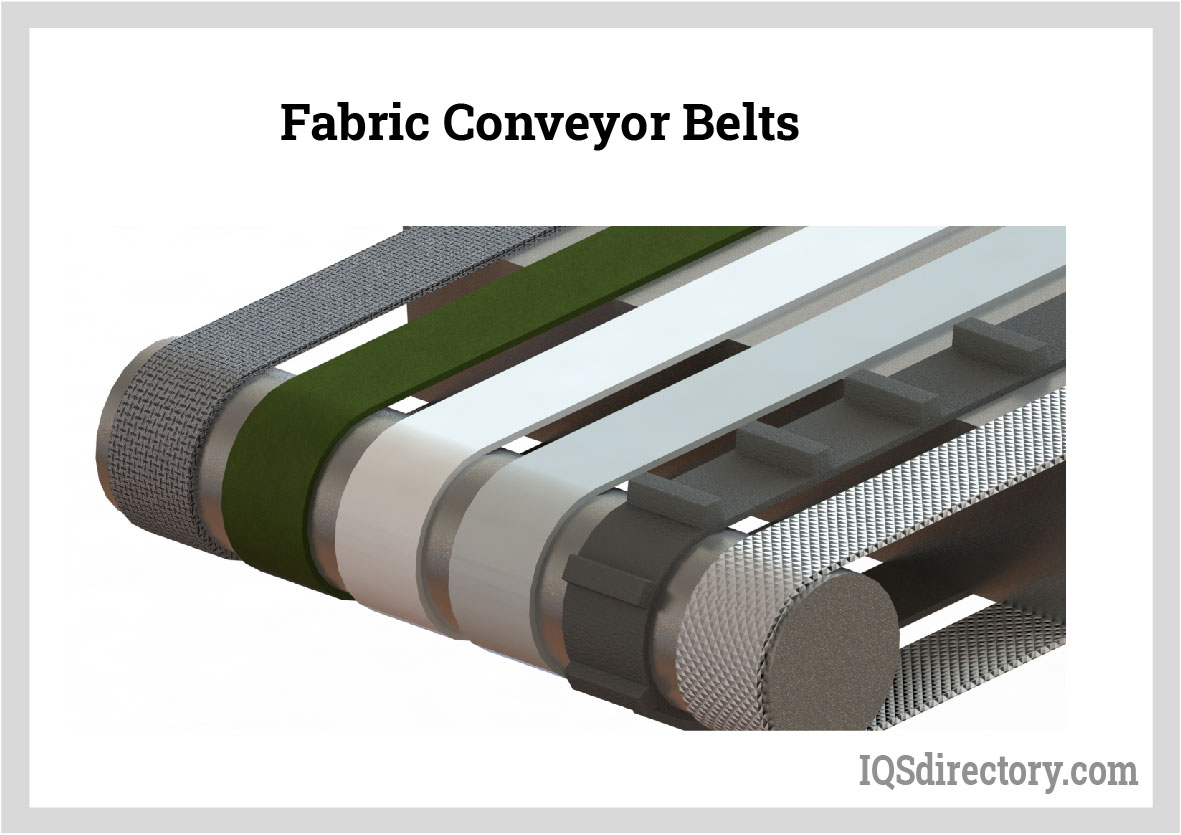 Fabric conveyor belts are cost effective for short conveying systems with lower capacity and is made of several layers of synthetic fabrics treated to prevent elongation.
Fabric conveyor belts are cost effective for short conveying systems with lower capacity and is made of several layers of synthetic fabrics treated to prevent elongation.
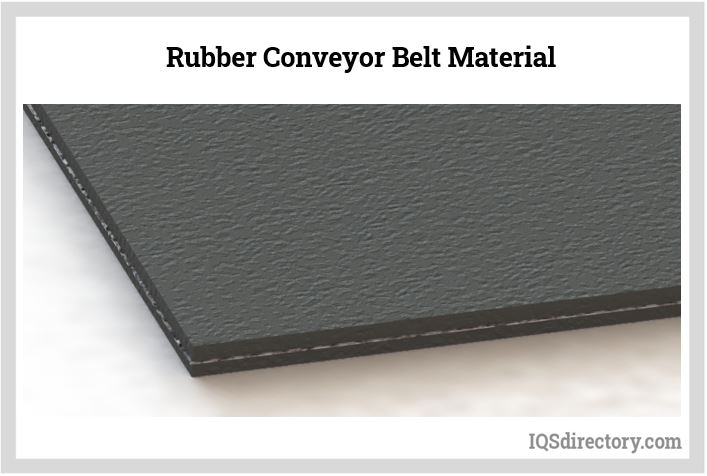 The surface of the roller bed conveyor belt is a set of rollers that match the weight and speed by the product in order to reduce friction.
The surface of the roller bed conveyor belt is a set of rollers that match the weight and speed by the product in order to reduce friction.
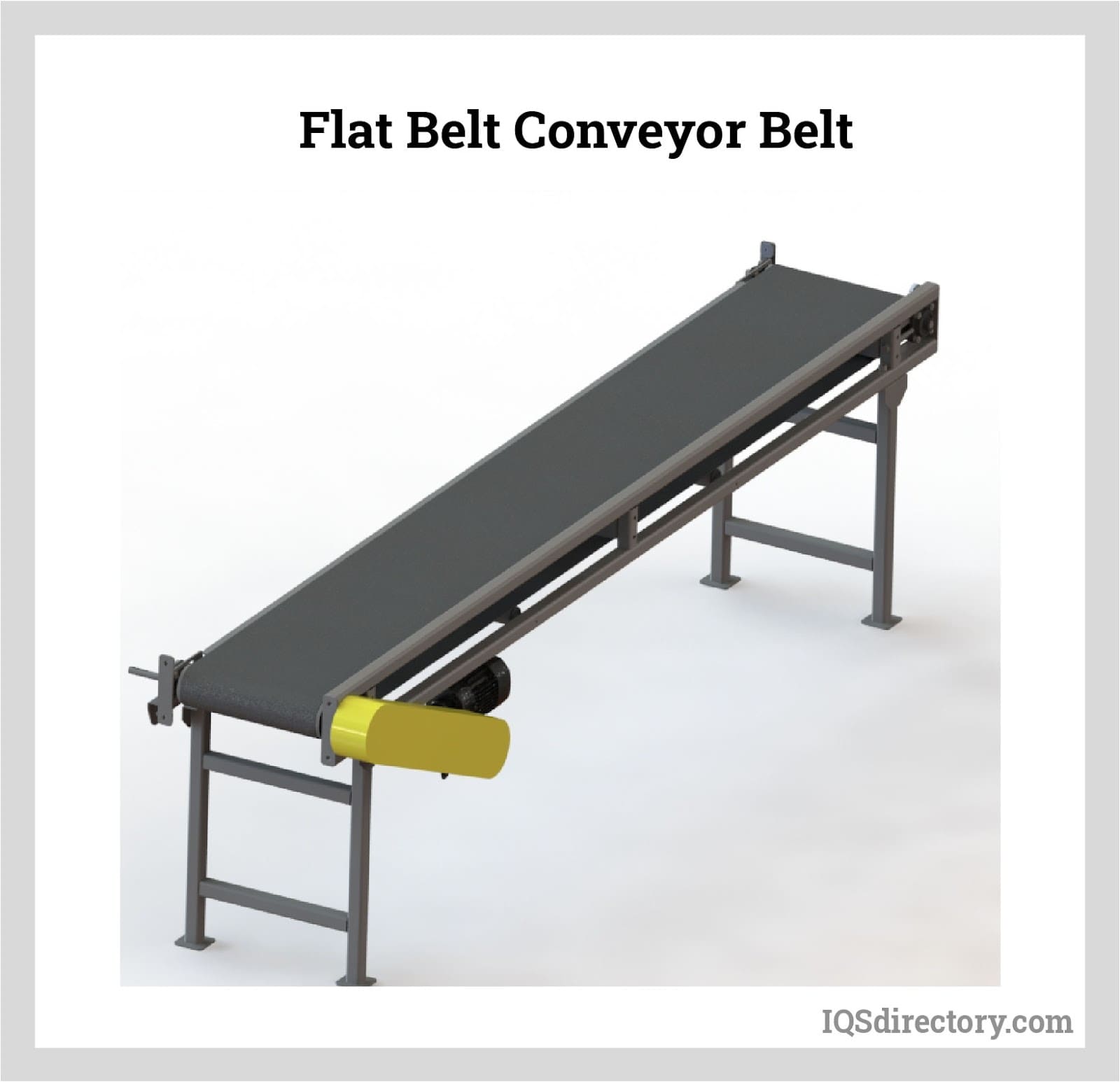 Flat belt conveyor belts uses a series of pulleys to move materials and supplies.
Flat belt conveyor belts uses a series of pulleys to move materials and supplies.
Types of Conveyors
-
Portable Conveyor Belts
These conveyors are designed to be easily moved from one location to another, making them ideal for applications where mobility is important but not constantly required. Portable units typically consist of roller conveyor belts made with galvanized steel rollers mounted at regular intervals along a sturdy frame. Commonly found on construction sites, loading docks, and in small-scale business operations, portable conveyors help streamline the handling of products in temporary or flexible setups.
Heavy Duty Roller
These conveyor systems are built to manage loads exceeding 500 pounds. They are engineered for strength and reliability and are capable of moving materials at speeds of up to 75 feet per minute, making them suitable for demanding industrial environments.
Vertical Conveyor Systems
Also known as spiral conveyor systems, these units are used to transport materials between different vertical levels. A vertical lift system uses a platform or arms to raise products, while a spiral conveyor features a screw-type belt that allows for continuous movement of materials at a gradual incline. These systems are widely used in distribution centers and manufacturing plants where vertical space optimization is necessary.
Vibrating Conveyor Systems
These systems feature a flat belt with an upturned lip, installed at a side angle to assist with sorting and moving materials that are hot, corrosive, dirty, or otherwise harsh. They are also popular in food processing and pharmaceutical industries where sanitary handling is essential. The vibration aids in moving materials gently yet efficiently while minimizing contamination.
Pneumatic Conveyor Systems
Pneumatic systems use compressed air to transport lightweight or powdery substances—such as fly ash—through an interconnected network of tubes or pipes. In addition to industrial use, they are commonly seen in drive-up banking facilities for transporting documents and cash quickly and securely.
Mining and Dredging Operations
In mining and dredging, various types of conveyor systems are employed to handle tough materials. Bucket conveyors, screw (or auger) conveyors, and overland conveyors are key to these operations. Overhead I-beam conveyor systems, typically chain-driven, are used in environments like automotive repair shops and metalworking facilities. These conveyors support the efficient movement of heavy parts and tools across workstations. A comprehensive list of screw conveyor manufacturers is available on the IQS Directory website .
Types of Conveyor Belts
-
Anti-Static Belts
Designed without static-prone materials like carbon, these belts reduce or eliminate static buildup during operation.
Anti-Vibration Belts
Engineered to minimize vibrations across conveyor systems, especially useful in setups with misaligned pulleys. These belts help prevent gradual wear, stretching, and abrasion caused by constant vibration.
Armored Belts
Reinforced with crosswise insertions in the belt cover—often made from materials like steel—to resist tearing from sharp or abrasive conveyed items.
Cable Belts
Belts strengthened with internal metal cables running lengthwise. These cables provide exceptional tensile strength, ideal for heavy-duty applications.
Conveyor Belt Materials
Common materials used in the construction of conveyor and power transmission belts include rubber, plastic, leather, and various metals, each selected for its specific performance characteristics.
Endless Belting
Belts that are manufactured as a continuous loop without seams. These belts offer smooth, consistent operation and even wear over time.
Fin Belts
Equipped with fin-like projections that help guide or position items. Ideal for tasks like catching containers and placing them into boxes during packaging operations.
Flat Belts
Characterized by their flat surface, these belts are typically used in conveyor systems requiring linear motion, in contrast to round or v-shaped belts.
Industrial Belts
General category for power transmission and conveyor belts designed specifically for industrial environments and applications.
Multi-Speed Belts
Used in systems requiring variable speed capabilities, such as those found in vehicles like cars and snowmobiles.
Nylon Belts
Manufactured from solid extruded high-grade nylon (polyamide), these belts offer durability and strength for conveying and power transmission tasks.
O-Ring Belts
Also called round or endless belts, these circular-profile belts are suitable for both light and heavy-duty low torque applications.
Plastic Conveyor Belts
Constructed from molded or shaped plastic materials, these belts are widely used in applications requiring resistance to chemicals, moisture, or easy sanitation.
Power Transmission Belts
Belts that are used to transfer power from one mechanical component to another within a system.
Round Belts
Conveyor or transmission belts with a circular cross-section, commonly used in power transmission and certain conveying applications.
Rubber Belting Elastic belts made from natural or synthetic rubber. Natural rubber is derived from the Para rubber tree, while synthetic variants include neoprene, silicone, and others, all suitable for a wide range of conveyor belt needs.
Specialty Belting
Custom or non-standard belts used for unique applications, either as power transmission tools in unconventional engines or as material-handling solutions in non-standard conveyor setups.
Timing Belt
Power transmission belts specifically used to control the timing of mechanical systems, particularly in automotive engines to regulate valve operation.
Twisted Belts
Designed to replace damaged endless round belts. These belts can be installed quickly without dismantling the drive system, making them ideal for emergency maintenance.
Urethane Belting
A commonly misused term for polyurethane belts. Although the names are similar, urethane and polyurethane are chemically distinct materials, with polyurethane being the correct term in most belting applications.
V-Belts
Belts with a v-shaped cross-section. They come in various types, typically standard or inverted, and are used for power transmission in many mechanical systems.
Maintaining the Beltline
The first step in maintaining a conveyor belt system is selecting the right system for the specific project. The goal should be to choose a conveyor that performs the required task efficiently without demanding unnecessary space, time, or energy. Size, layout, and drive type will all depend on the material being conveyed and the logistics of the operation. Once the appropriate conveyor system is installed, the schedule and intensity of inspection and maintenance will largely be determined by how frequently and how long the system is used.
Take-up adjustment is a critical part of conveyor system maintenance. It refers to the ability to compensate for displacement or slack in the system. In chain-driven systems, chains can gradually elongate, leading to looseness that reduces efficiency and may pose safety risks. When belt tension is not properly maintained, belts may slip off the rollers, twist, or even tear. Belt lacing that becomes stretched or loose should be replaced promptly. Proper belt tensioning not only ensures smooth operation but also extends the lifespan of both carrier and drive belts.
Because conveyor systems consist of continuously moving components, they require consistent lubrication using suitable lubricants. Environmental contamination, part degradation, or interaction with conveyed materials must be minimized. For instance, dust generated by cardboard boxes can quickly interfere with the system’s functionality. Cleanliness is crucial, and the use of a reliable dust collection system is essential. Routine inspections should include checks for worn belting, damaged rollers or pulleys, loose bolts, screws, springs, or hooks, as well as any signs of rust or corrosion. These ongoing maintenance efforts are fundamental to keeping the system running safely and efficiently.
Innovative Uses for Conveyors
With conveyor belts now commonly visible in many public and industrial spaces, the idea of utilizing their surface space for advertising or messaging has become increasingly practical. Much like the "crawler lines" seen on television broadcasts or messages displayed on digital public signage, the uncovered sections of the belt—those not obscured by the items being transported—offer a valuable opportunity for communication. In factory environments, these messages might serve as safety reminders for workers. In public settings, the messaging could range from public service announcements to promotional advertising, taking advantage of the belt’s constant motion and visibility.
Finding the Right Conveyor System
When searching for conveyor systems for a business, it’s essential to understand the full scope of material handling involved. The size, shape, and rigidity of the materials being moved will directly influence which type of conveyor is most suitable. The distance the materials must travel will help determine which features are necessary for optimal performance. Consideration must also be given to the travel path—whether the system operates in a straight, continuous motion or requires turns, elevation changes, or intermittent stops along the route. Future expansion or system reconfiguration should also be factored into the initial planning process.
A knowledgeable conveyor system representative will assess the workspace environment and operational needs when recommending or designing a system. ISO standards offer more than 100 detailed guidelines related to conveyor belt and system safety, performance, and quality, each specific to different application types. A reputable dealer will understand how to apply these standards appropriately, ensuring the system selected is the best fit for the job. You’ll find a convenient list of producers we work with at the top of this page.
Conveyor Belt Terms
-
Automatic Take-Up
A mechanism used to maintain proper tension in a conveyor belt, compensating for natural stretching or shrinking during operation.
Backstop
A safety device that prevents an elevator conveyor belt from moving backward once it has stopped.
Bed
The flat surface over which the conveyor belt slides during operation.
Belt Clamp
Metal plates or beams positioned at either end of a conveyor belt to secure it in place.
Belt Fastener
A component used to join the ends of a conveyor belt securely.
Belt Installer
A tool designed to assist in installing belts onto roller systems. It speeds up the process and eliminates the need for manual belt placement.
Belt Width
The total distance across a conveyor belt, measured from the outer edge of one rod to the outer edge of the rod on the opposite side.
Carrying Run
The portion of the conveyor belt that transports the load between the loading and discharge points.
C-Clip
A clamping device attached to shafts to keep spools properly positioned.
Clinched Selvage
A method of securing connecting rods by looping the end of a rod through an extra hole at each belt edge and bending it so it lies parallel with the belt strip.
Drive Sprockets
Sprockets located at the discharge end of a conveyor, responsible for pulling the loaded belt under power.
Drive Tension
The maximum tension a conveyor belt can withstand before failure.
Flexing
The action of bending in a conveyor belt as it moves over rollers or around pulleys.
Immediate Set
The amount of visible deformation in a belt that remains immediately after the removal of a load.
Impact Resistance
A measure of a conveyor belt’s ability to absorb forceful loads without sustaining damage.
Lateral Pitch
The measurement across the width of the belt between the centers of two adjacent drive openings.
Mesh
An open, grid-like material structure; in belting, wire mesh is used as a durable, heavy-duty belt option.
Pulley
A grooved wheel used to guide and support belts or chains, allowing for direction change and load lifting. Typically located at either end of a conveyor belt system.
Reefed
Describes a belt folded back and forth onto itself.
Splice
The method of joining two ends of a conveyor belt, often by interweaving or using fasteners.
Spool
Functions like a clutch in conveyor systems. In the event of jams, spools allow belts to slip, preventing wear. They also provide safety by disengaging when objects like hair or hands become caught.